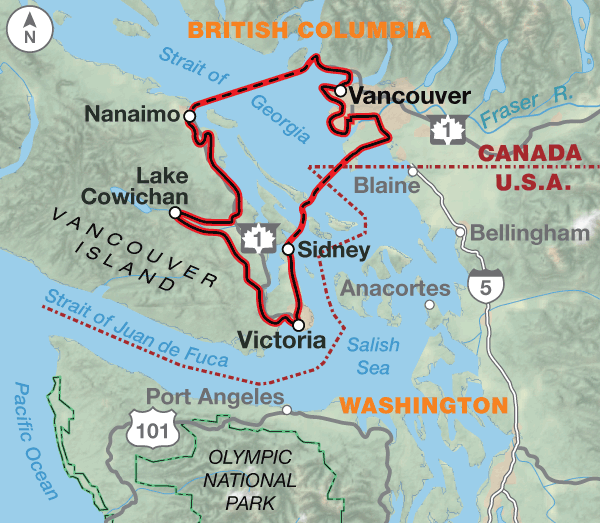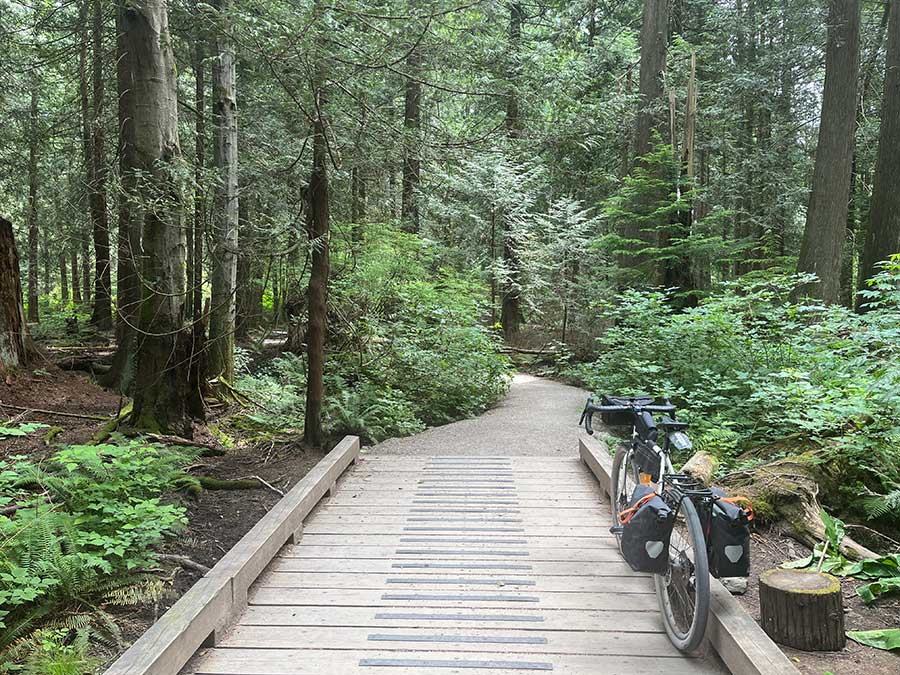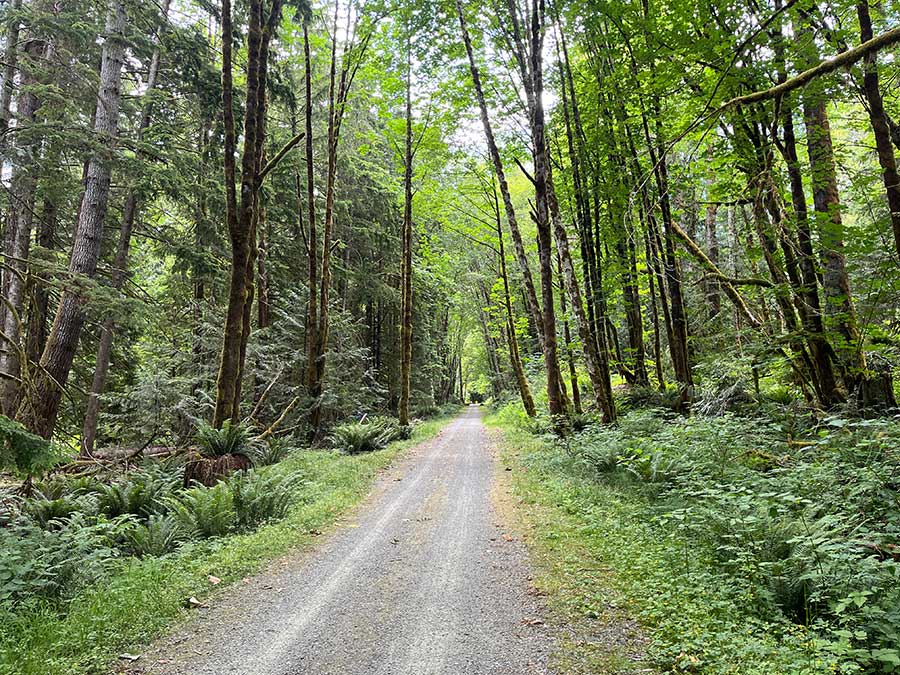Vancouver Crossing Loop

| Vancouver Crossing Loop | |
|---|---|
| 1. Victoria, BC to Victoria, BC | Detail |
The Vancouver Crossing Loop is DIGITAL-ONLY. No paper maps are produced for this route. This route is available digitally.
A Route as Varied as the Riders.
The Vancouver Crossing Loop begins at Clover Point in Victoria, British Columbia, a windswept perch on the edge of the Salish Sea where a small marker designates “Point Zero” of the Trans Canada Trail, the longest multi-use trail network in the world. From this shoreline, the route follows the southern tip of Vancouver Island through landscapes shaped by both natural forces and human history. The coast here has long been a place of salmon runs, tidal harvesting, maritime trade, and shifting cultural intersections.

In Victoria, the route passes Fisherman’s Wharf, a colorful floating community where seafood stalls, houseboats, and tour boats are anchored in the harbor. The scent of grilled halibut mingles with salt air, and marine life is often visible just below the docks. This area lies within the traditional and unceded territories of the Lekwungen (Songhees and Esquimalt) Peoples, and interpretive signs and public art share aspects of their living culture and deep connection to the land and waters.
A ferry crossing connects Vancouver Island to the Lower Mainland, opening a new stretch of coastal riding. The route travels through Steveston, once one of the busiest fishing ports in the province. The Gulf of Georgia Cannery National Historic Site preserves the history of a diverse workforce —Japanese, Chinese, Indigenous, and European — whose labor sustained a booming fishing and canning industry. Just upriver, Finn Slough offers a very different glimpse of the past, with weathered stilt houses and tidal channels evoking a slower, more precarious way of life along the Fraser River.
The shoreline in this part of the route is defined by ecologically rich wetlands, including Boundary Bay, Roberts Bank, and Sturgeon Bank Wildlife Management Areas. These intertidal zones are critical stopovers on the Pacific Flyway, drawing tens of thousands of migratory birds each spring and fall. Visitors may see flocks of sandpipers and dunlins, along with raptors such as the bald eagle, peregrine falcon, and northern harrier.
Approaching Vancouver, the route moves into one of the most culturally diverse cities in the world, where over half the population is made up of first-generation immigrants. Neighborhoods, markets, and storefronts reflect a wide range of traditions, and food culture is a highlight, with offerings that include Punjabi sweets, Chinese dumplings, and the rich, layered sweetness of the Nanaimo bar.
The route continues into North Vancouver via the SeaBus passenger ferry toward the historic Shipyards district. Once a center of wartime shipbuilding during the Second World War, these docks produced vessels that supported the Allied effort in the Pacific. Today, the area has been redeveloped with public spaces, markets, and waterfront paths that still retain a sense of its industrial heritage.
The return to Vancouver Island brings a shift in scenery as forests close in along the path. These are largely second and third-growth stands, but the remnants of old-growth Douglas fir remain visible in the massive, moss-covered stumps that line the trails. Logging roads and railways have been converted into recreational paths, and the scent of cedar is carried on the wind. The layered history of extraction, regeneration, and conservation is written into the land itself.
Continuing south, the trail approaches Langford, where Hatley Castle stands surrounded by manicured lawns, Japanese gardens, and imported plantings. Built in the early 20th century, the castle has served as both a military college and the home of Royal Roads University. Its architecture and grounds provide a striking example of Edwardian estate design on the Pacific coast.
The Vancouver Crossing Loop weaves together natural beauty, layered histories, and living cultures. From coastal wetlands alive with birdlife to the bustling streets of one of North America’s most multicultural cities, and from quiet fishing villages to forests reclaiming old industrial corridors, the route offers a multidimensional perspective on a region shaped by both land and sea for thousands of years.
CC Image courtesy of Alastair Smith on Flickr
TERRAIN
The route is generally flat from Victoria to downtown Vancouver, aside from a short, steep hill in Pacific Spirit Regional Park. West Vancouver brings some rolling hills, which can be bypassed via Marine Drive if you prefer an easier option. Back on Vancouver Island, the terrain grows hillier on the country roads between Nanaimo and Duncan. The Cowichan Valley Trail, being an old railroad grade, offers gentle and gradual climbs and descents between Duncan and Shawnigan Lake. The most challenging grades come on the Malahat Connector and Sooke Hills Wilderness Trail between Shawnigan Lake and Langford. While the climbs aren’t especially long, they are quite steep, and you will need to walk your bike in places.
Roughly 60% of the route is paved, and 40% is unpaved. The gravel roads and bike paths are generally smooth and well maintained, though the Sooke Hills Wilderness Trail features looser, chunkier gravel. For the best ride experience overall, we recommend a gravel or touring bike equipped with 42mm or wider tires.
NOTE: ferries have been excluded from metrics.
| Vancouver Crossing Loop | ||||
|---|---|---|---|---|
| Section | Distance | Elevation | Total Climb | Avg. Climb/mile |
| Total | 246.7 miles counterclockwise 245.5 miles clockwise miles | Minimum: 0 ft.Maximum:1,480 ft. | 11,461 ft. counterclockwise10,439 ft. clockwise | 46 ft. per mi. counterclockwise43 ft. per mi. clockwise |
LOGISTICS
The route formally begins and ends in Victoria, but you can start and finish anywhere on the loop that is convenient to you. Victoria is accessible from the United States via the Black Ball Ferry Line from Port Angeles or the Victoria Clipper from Seattle. If flying, Victoria International Airport offers the easiest access to the route, but Vancouver International Airport is often the cheaper option. You can also reach the route by train at Pacific Central Station in downtown Vancouver, served by the Amtrak Cascades route (U.S.) and VIA Rail Western Canada Route.
The route was originally designed and researched counterclockwise but can be ridden in either direction. If starting and ending in Victoria, riding in the counterclockwise direction will save the most scenic, challenging, and rewarding portion for last (between Lake Cowichan and Langford).
This route can be ridden anytime between late spring to early fall (typically early May to September). Unpaved portions of the route may be muddy when wet. Regardless of weather, a gravel or touring bike with 42mm tires or wider is recommended for this route.
There are three ferries on the route: Swartz Bay to Tsawwassen (1 hr 34 min), the SeaBus across Vancouver Harbor (12 min), and Horseshoe Bay to Departure Bay (1 hr 42 min). For the two longer ferries, plan to arrive 30-60 minutes before departure. Food and drinks are available onboard, which can be logistically helpful if you want to schedule your ferry crossing around mealtime. Reservations are available but not required. The SeaBus Ferry runs every 15 minutes from early in the morning to late at night.
Services are sparse along the route for 60 kilometers (37 miles) between Tsawwassen and Steveston, despite travelling through a mostly urbanized area. For lunch, some fast-food restaurants can be found on Annacis Island, in Queensborough, and near the Steveston Highway crossing in Richmond.
If you are planning to camp, be aware that only two campgrounds on the mainland portion of the route offer tent camping (as of 2025): Tsawwassen RV Resort in Tsawwassen and Capilano River RV Park in North Vancouver. They are 83 miles apart, so you will likely need to plan for at least one night indoors in the Richmond or Vancouver area. Keep in mind that Vancouver is an especially expensive city, so expect higher costs for accommodations and other purchases. Camping on Vancouver Island is plentiful, but be sure to make reservations. The campgrounds can be very busy during the summer season. You may also wish to sign up with Warmshowers, a reciprocal hospitality site for bicycle travelers, for other overnight options.
The route between Duncan and Langford is bear country. Use caution, keep your distance, and carry bear spray especially if camping. Bear spray can be purchased in Duncan or Victoria/Langford depending on your direction.
The 76-kilometre (47-mile) stretch between Lake Cowichan and Langford is by far the most remote, scenic, and challenging portion of the entire route, but it’s also the most rewarding. The Malahat Connector and Sooke Hills Wilderness Trail south of Shawnigan Lake will require walking your bike up some short but very steep sections. Be sure to allow extra time for this section. There are no services on this portion of the route, so stock up on food, water, and supplies before entering the forest.
Vancouver Crossing Loop Highlights:
- Clover Point
- Beacon Hill Park
- Downtown Victoria
- Lochside Trail
- Swartz Bay to Tsawwassen Ferry through the Gulf Islands
- Watershed Park
- Steveston Village
- Pacific Spirit Regional Park
- False Creek/Granville Island
- Stanley Park/Seawall
- Downtown Vancouver
- SeaBus ferry
- The Spirit Trail
- Ferry from Horseshoe Bay to Nanaimo
- Bowen Park
- Colliery Dam Park
- Ladysmith & Chemainus
- Cowichan Valley Trail
- Lake Cowichan
- Sooke Hills Wilderness Trail
- Goldstream Suspension Bridge
- Hatley Castle
More Route Resources:
- Galloping Goose Trail
- Lochside Regional Trail
- The Flight Path multi-use trail
- British Columbia Ferries
- Travelling with your bike on BC ferries
- Boundary Bay Dyke Trail
- Delta South Surrey Regional Greenway
- Watershed Park
- West Dyke Trail
- Stanley Park
- SeaBus
- The Spirit Trail
- Cowichan Valley Trail
- Cowichan River Provincial Park
- Sooke Hills Wilderness Trail
- E&N Rail Trail
Updates to Recently Released Maps
If you are planning a bike tour, be sure to get the most recent map updates and corrections for your route by selecting the route, and the appropriate section(s), from the drop-down menu below.
Over time maps become less useful because things change. Every year Adventure Cycling’s Routes and Mapping Department create map updates and corrections for every map in the Adventure Cycling Route Network, which now totals 52,047 miles. With the help of touring cyclists like you, we receive updates on routing, services, camping, and contact information. Until we can reprint the map with the new information, we verify the suggested changes and publish corrections and updates here on our website.
PLEASE NOTE: Covid has been particularly hard on the small businesses along our routes. While we do our best to keep the maps and these online updates current, you may encounter more closed businesses and longer stretches with limited or no services.
Refer to these updates for the most current information we have and submit reports of changes to the Route Feedback Form for the cyclists coming after you.
NOTE: Map updates and corrections only pertain to long term changes and updates. For short term road closures, please see the Adventure Cycling’s Routes Temporary Road Closures discussion in our Forums.






